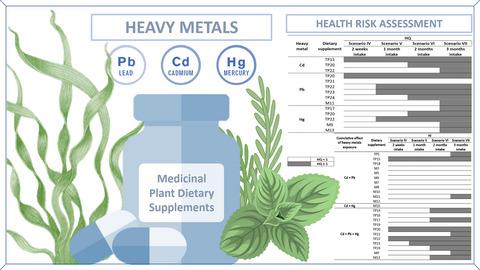当前位置:
X-MOL 学术
›
Food Sci. Nutr.
›
论文详情
Our official English website, www.x-mol.net, welcomes your
feedback! (Note: you will need to create a separate account there.)
Health risks from consumption of medicinal plant dietary supplements.
Food Science & Nutrition ( IF 3.5 ) Pub Date : 2020-05-19 , DOI: 10.1002/fsn3.1636 Małgorzata Ćwieląg-Drabek 1 , Agata Piekut 1 , Iwona Szymala 2 , Klaudia Oleksiuk 3 , Mehdi Razzaghi 4 , Weronika Osmala 1 , Konstancja Jabłońska 1 , Grzegorz Dziubanek 1
Food Science & Nutrition ( IF 3.5 ) Pub Date : 2020-05-19 , DOI: 10.1002/fsn3.1636 Małgorzata Ćwieląg-Drabek 1 , Agata Piekut 1 , Iwona Szymala 2 , Klaudia Oleksiuk 3 , Mehdi Razzaghi 4 , Weronika Osmala 1 , Konstancja Jabłońska 1 , Grzegorz Dziubanek 1
Affiliation

|
The aim of this study was to determine the heavy metal contents of dietary supplements manufactured from medicinal plants and assess the potential daily burden on their consumers. The study consisted of 41 dietary supplements produced from terrestrial plants or microalgae. The analysis of cadmium, lead, and mercury content was performed using analytical methods. The content of Cd and Pb was determined by flame atomic absorption spectrometry (FAAS). The mercury content was determined using atomic absorption spectrometry with the generation of cold mercury vapor (CVAAS). The presence of at least one of the three analyzed heavy metals was found in 79.2% samples of supplements produced from terrestrial plants and in 88.2% supplement samples produced from microalgae. Hazard quotient was used to calculate noncarcinogenic risk for humans by ingestion of dietary supplements containing heavy metals. From among all supplements, 68.3% of samples were contaminated with Cd and Pb (this does not always apply to the same samples) and 29.3% of samples were contaminated with Hg. The health risk assessment of consumers of dietary supplements showed, in an extreme case, that taking this supplement for only one week poses a health risk associated with exposure to Pb. The health risk associated with the intake of dietary supplements primarily depends on the duration of consumption.
中文翻译:

食用药用植物膳食补充剂的健康风险。
本研究的目的是确定药用植物制成的膳食补充剂的重金属含量,并评估消费者的潜在日常负担。该研究包括 41 种由陆生植物或微藻生产的膳食补充剂。采用分析方法对镉、铅和汞含量进行分析。采用火焰原子吸收光谱法(FAAS)测定Cd和Pb的含量。使用原子吸收光谱法并产生冷汞蒸气(CVAAS)测定汞含量。在 79.2% 的陆生植物补充剂样品和 88.2% 的微藻补充剂样品中发现了所分析的三种重金属中的至少一种。危害商用于计算人类摄入含有重金属的膳食补充剂的非致癌风险。在所有补充剂中,68.3% 的样品受到 Cd 和 Pb 污染(这并不总是适用于相同的样品),29.3% 的样品受到 Hg 污染。对膳食补充剂消费者的健康风险评估表明,在极端情况下,仅服用该补充剂一周就会产生与接触铅相关的健康风险。与摄入膳食补充剂相关的健康风险主要取决于摄入的持续时间。
更新日期:2020-05-19
中文翻译:

食用药用植物膳食补充剂的健康风险。
本研究的目的是确定药用植物制成的膳食补充剂的重金属含量,并评估消费者的潜在日常负担。该研究包括 41 种由陆生植物或微藻生产的膳食补充剂。采用分析方法对镉、铅和汞含量进行分析。采用火焰原子吸收光谱法(FAAS)测定Cd和Pb的含量。使用原子吸收光谱法并产生冷汞蒸气(CVAAS)测定汞含量。在 79.2% 的陆生植物补充剂样品和 88.2% 的微藻补充剂样品中发现了所分析的三种重金属中的至少一种。危害商用于计算人类摄入含有重金属的膳食补充剂的非致癌风险。在所有补充剂中,68.3% 的样品受到 Cd 和 Pb 污染(这并不总是适用于相同的样品),29.3% 的样品受到 Hg 污染。对膳食补充剂消费者的健康风险评估表明,在极端情况下,仅服用该补充剂一周就会产生与接触铅相关的健康风险。与摄入膳食补充剂相关的健康风险主要取决于摄入的持续时间。











































 京公网安备 11010802027423号
京公网安备 11010802027423号